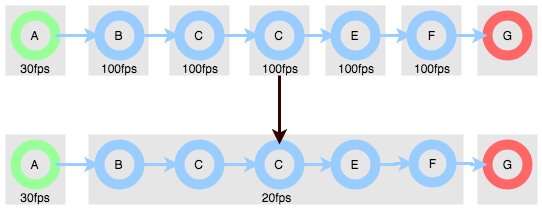Common Flow Development Patterns¶
Reducing the number of tasks to be used¶
Assume that we want to run the following flow in a machine that has 4 CPU cores:
from videoflow.producers import IntProducer
from videoflow.processors import IdentityProcessor
from videoflow.consumers.import CommandlineConsumer
A = IntProducer(0, 40, fps = 30)
B = IdentityProcessor(fps = 300)(A)
C = IdentityProcessor(fps = 300)(B)
D = IdentityProcessor(fps = 300)(C)
E = IdentityProcessor(fps = 300)(D)
F = IdentityProcessor(fps = 300)(E)
G = CommandlineConsumer()(F)

The execution engine will take this graph of 7 nodes, and will create 7 corresponding tasks, each one running on its independent process.

Usually, the consumers and producers are I/O bound tasks, while the
processors are CPU bound tasks. If you have more CPU bound tasks than CPU physical
cores in your system, this can introduced some unwanted or unnecessary
synchronization overhead. One way to solve this problem is to group
multiple nodes under the same task. In order to do that, we can
use the TaskModuleNode.
The TaskModuleNode wraps a subgraph of processor nodes, and has the effect
that the execution engine allocates only one task to execute this subgraph.
Using the TaskModuleNode the previous example would look like:
from videoflow.producers import IntProducer
from videoflow.processors import IdentityProcessor
from videoflow.consumers.import CommandlineConsumer
from videoflow.core.node import TaskModuleNode
A = IntProducer(0, 40, fps = 30)
B = IdentityProcessor(fps = 300)(A)
C = IdentityProcessor(fps = 300)(B)
D = IdentityProcessor(fps = 300)(C)
E = IdentityProcessor(fps = 300)(D)
F = IdentityProcessor(fps = 300)(E)
task_module = TaskModuleNode(entry_node = B, exit_node = F)
G = CommandlineConsumer()(task_module)

Note
- There are certain restrictions in the usage of the
TaskModuleNode: All nodes on its subgraph must be processor nodes.
No node on its subgraph can have
device_typeto beGPUThere cannot be a
TaskModuleNodenested inside aTaskModuleNode.
Notice that now nodes A, B, C, D, E and F are not executed in parallel,
but sequentially, and that effectively reduces the fps of the flow
in that section of the graph.
Warning
You need to be careful when using TaskModuleNode. You can effectively
introduce bottlenecks in the flow if you are not careful.
The picture below contains an example of such a case:
